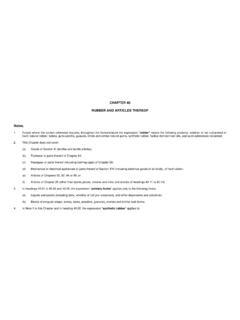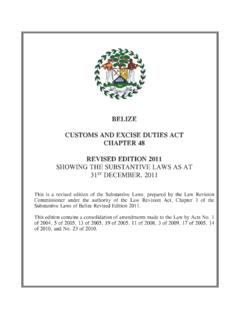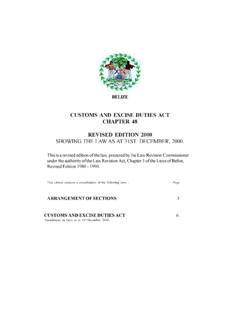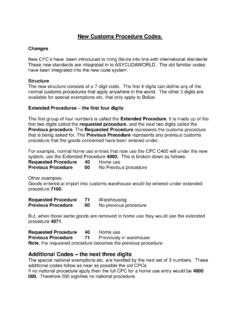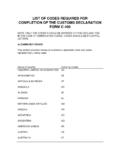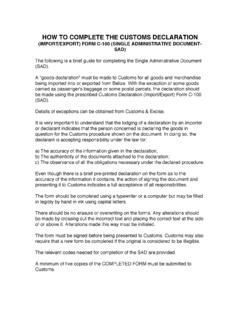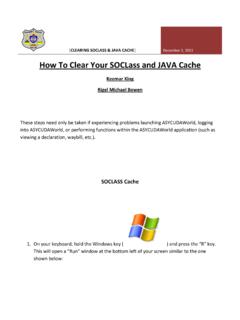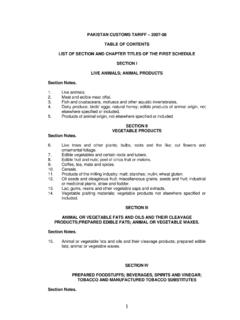Transcription of CHAPTER 72 IRON AND STEEL Notes. - Customs
1 CHAPTER 72. IRON AND STEEL . Notes. 1. In this CHAPTER and, in the case of Notes (d), (e) and (f) throughout the Nomenclature, the following expressions have the meanings hereby assigned to them: (a) Pig iron Iron-carbon alloys not usefully malleable, containing more than 2% by weight of carbon and which may contain by weight one or more other elements within the following limits: - not more than 10% of chromium - not more than 6% of manganese - not more than 3% of phosphorus - not more than 8% of silicon - a total of not more than 10% of other elements. (b) Spiegeleisen Iron-carbon alloys containing by weight more than 6% but not more than 30% of manganese and otherwise conforming to the specification at (a) above.
2 (c) Ferro-alloys Alloys in pigs, blocks, lumps or similar primary forms, in forms obtained by continuous casting and also in granular or powder forms, whether or not agglomerated, commonly used as an additive in the manufacture of other alloys or as de-oxidants, de- sulphurising agents or for similar uses in ferrous metallurgy and generally not usefully malleable, containing by weight 4% or more of the element iron and one or more of the following: - more than 10% of chromium - more than 30% of manganese - more than 3% of phosphorus - more than 8% of silicon - a total of more than 10% of other elements, excluding carbon, subject to a maximum content of 10% in the case of copper.
3 (d) STEEL Ferrous materials other than those of heading which (with the exception of certain types produced in the form of castings) are usefully malleable and which contain by weight 2% or less of carbon. However, chromium steels may contain higher proportions of carbon. (e) Stainless STEEL Alloy steels containing, by weight, or less of carbon and or more of chromium, with or without other elements. (f) Other alloy STEEL Steels not complying with the definition of stainless STEEL and containing by weight one or more of the following elements in the proportion shown: - or more of aluminium, - or more of boron, - or more of chromium, - or more of cobalt, - or more of copper - or more of lead, - or more of manganese, - or more of molybdenum, - or more of nickel, - or more of niobium - or more of silicon, - or more of titanium, - or more of tungsten (wolfram), - or more of vanadium, - or more of zirconium - or more of other elements, (except sulphur, phosphorus, carbon and nitrogen), taken separately.
4 (g) Remelting scrap ingots of iron or STEEL Products roughly cast in the form of ingots without feeder-heads or hot tops, or of pigs, having obvious surface faults and not complying with the chemical composition of pig iron, spiegeleisen or ferro-alloys. (h) Granules Products of which less than 90% by weight passes through a sieve with a mesh aperture of 1 mm and of which 90% or more by weight passes through a sieve with a mesh aperture of 5 mm. (ij) Semi-finished products Continuous cast products of solid section, whether or not subjected to primary hot-rolling; and Other products of solid section, which have not been further worked than subjected to primary hot-rolling or roughly shaped by forging, including blanks for angles, shapes or sections.
5 These products are not presented in coils. (k) Flat-rolled products Rolled products of solid rectangular (other than square) cross-section, which do not conform to the definition at (ij) above in the form of: - coils of successively superimposed layers, or - straight lengths, which if of a thickness less than mm are of a width measuring at least ten times the thickness or if of a thickness of mm or more are of a width which exceeds 150 mm and measures at least twice the thickness. Flat-rolled products include those with patterns in relief derived directly from rolling (for example, grooves, ribs, chequers, tears, buttons, lozenges) and those which have been perforated, corrugated or polished, provided that they do not thereby assume the character of articles or products of other headings.
6 Flat-rolled products of a shape other than rectangular or square, of any size, are to be classified as products of a width of 600 mm or more, provided that they do not assume the character of articles or products of other headings. (l) Bars and rods, hot-rolled, in irregularly wound coils Hot-rolled products in irregularly wound coils, which have a solid cross-section in the shape of circles, segments of circles, ovals, rectangles (including squares), triangles or other convex polygons (including "flattened circles" and "modified rectangles", of which two opposite sides are convex arcs, the other two sides being straight, of equal length and parallel).
7 These products may have indentations, ribs, grooves or other deformations produced during the rolling process (reinforcing bars and rods). (m) Other bars and rods Products which do not conform to any of the definitions at (ij), (k) or (l) above or to the definition of wire, which have a uniform solid cross-section along their whole length in the shape of circles, segments of circles, ovals, rectangles (including squares), triangles or other convex polygons (including "flattened circles" and "modified rectangles", of which two opposite sides are convex arcs, the other two sides being straight, of equal length and parallel). These products may: - have indentations, ribs, grooves or other deformations produced during the rolling process (reinforcing bars and rods).
8 - be twisted after rolling. (n) Angles, shapes and sections Products having a uniform solid cross-section along their whole length which do not conform to any of the definitions at (ij), (k), (l) or (m) above or to the definition of wire. CHAPTER 72 does not include products of heading or (o) Wire Cold-formed products in coils, of any uniform solid cross-section along their whole length, which do not conform to the definition of flat-rolled products. (p) Hollow drill bars and rods Hollow bars and rods of any cross-section, suitable for drills, of which the greatest external dimension of the cross-section exceeds 15 mm but does not exceed 52.
9 Mm, and of which the greatest internal dimension does not exceed one half of the greatest external dimension. Hollow bars and rods of iron or STEEL not conforming to this definition are to be classified in heading 2. Ferrous metals clad with another ferrous metal are to be classified as products of the ferrous metal predominating by weight. 3. Iron or STEEL products obtained by electrolytic deposition, by pressure casting or by sintering are to be classified, according to their form, their composition and their appearance, in the headings of this CHAPTER appropriate to similar hot-rolled products. Subheading Notes. 1. In this CHAPTER the following expressions have the meanings hereby assigned to them: (a) Alloy pig iron Pig iron containing, by weight, one or more of the following elements in the specified proportions: -more than of chromium, -more than of copper, -more than of nickel, -more than of any of the following elements: aluminium, molybdenum, titanium, tungsten (wolfram), vanadium.
10 (b) Non-alloy free-cutting STEEL Non-alloy STEEL containing, by weight, one or more of the following elements in the specified proportions: or more of sulphur , or more of lead , -more than of selenium, -more than of tellurium, -more than of bismuth. (c) Silicon-electrical STEEL Alloy steels containing by weight at least but not more than 6% of silicon and not more than of carbon. They may also contain by weight not more than 1% of aluminium but no other element in a proportion that would give the STEEL the characteristics of another alloy STEEL . (d) High speed STEEL Alloy steels containing, with or without other elements, at least two of the three elements molybdenum, tungsten and vanadium with a combined content by weight of 7% or more, or more of carbon and 3 to 6% of chromium.
